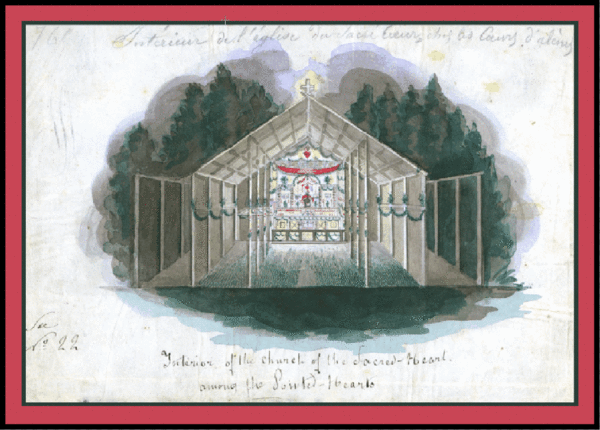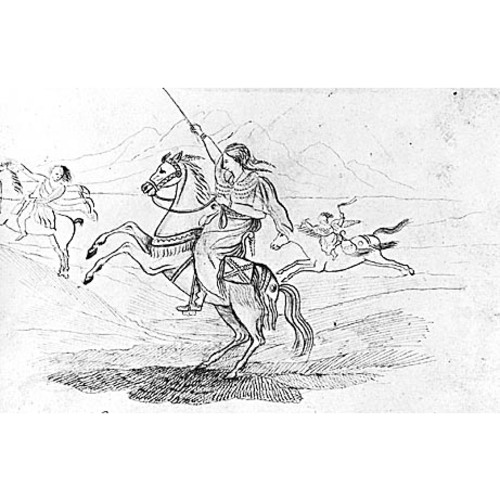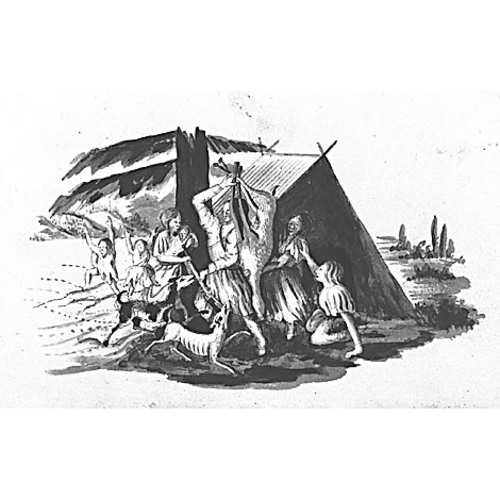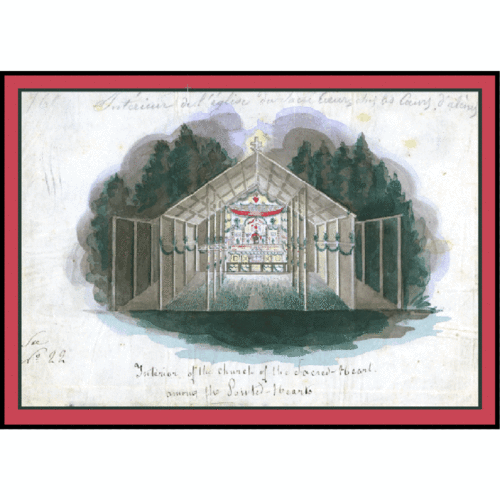
Source: Link
POINT, NICOLAS, Jesuit priest and missionary; b. 10 April 1799 in Rocroi, Ardennes, France, son of François Point, carpenter, and Marie-Nicole Boursois; d. 3 July 1868 at Quebec.
Born during an unsettled period in the history of France, the education of Nicolas Point was sketchy. His father’s early death required him to take employment as a lawyer’s drudge at 13 to help his widowed mother support a large family, of which he was, apparently, the eldest. Even as a young child he could sketch well and his mother encouraged his talent. Reading a life of St Francis Xavier engendered in him an interest in the missions and probably led him to apply for entrance into the Society of Jesus. He entered that order at Saint-Acheul, Somme, on 28 June 1819, and he was ordained a priest at Sion, Switzerland, on 20 March 1831.
At the request of Benoît-Joseph Flaget, first bishop of Louisville, Ky, he and several other Jesuits were sent in 1835 to open a college at Lebanon, Ky. That venture failed, and Point was sent to Louisiana where, under the direction of Antoine Blanc, bishop of New Orleans, he began Saint Charles College at Grand Coteau. The school opened in 1837, but did not prosper under Point’s direction. In the spring of 1840 Point was called by his superiors to St Louis and sent to Westport (today in Kansas City, Mo.) to prepare for an expedition of six Jesuits, led by Pierre-Jean De Smet*, who were to open a mission among the Flatheads in the northwestern United States. Point worked there tirelessly for the following six years. He established at least one mission, that of the Sacred Heart among the Skitswish (Coeur d’Alenes) at a site near the present Cataldo, Idaho. Throughout this period he kept a journal and made in it hundreds of sketches of Indians in every phase of their existence. Point also made many sketches which were to appear in De Smet’s books.
At his own request, Point was recalled in 1847, and he went to Windsor, Canada West, to join his brother Pierre who was in charge of a parish serving mainly Indians. In 1848 he was transferred to Wikwemikong, on Manitoulin Island, where the Indian mission of Sainte-Croix was conducted by the Jesuits. During his years there, he built a stone church, started schools for Indian girls and boys, established pious societies (chiefly in an effort to combat the effects of drunkenness), and encouraged large-scale agriculture among the Indians. In 1855 his health gave out and he was sent to the Jesuit house at Sault-au-Récollet (Montreal) to recover. It was there that he reorganized his journal, with its interleaves of drawings in colour. This precious work, composed of six ledger-sized manuscript volumes, he called “Souvenirs des Montagnes Rocheuses.”
For most of the rest of his life Point was an invalid. In 1865 his superiors sent him to Quebec where he became a highly sought after adviser to the local clergy. He died at Quebec on 3 July 1868. He was so much admired by the clergy, particularly the canons, that they insisted on his burial in the crypt under the cathedral.
Point’s work as an artist is said by some to be primitive, but it is also original in its technique. His paintings are especially valuable because they portray the daily life of several Indian tribes, the Flatheads, Blackfeet, and Skitswish for the most part, just before they were radically changed by the incursion of the white man.
[Nicolas Point left a large body of manuscript material which is scattered through several archives. The Archivum Romanum Societatis Iesu (Rome), Epistolae praepositorum generalium ad patres et fratres Societatis Iesu, has a collection of his letters to the Jesuit general and of the baptismal records he kept while on the missions in the Oregon country. The Biblioteca Nazionale Centrale (Rome), Fondo Gesuitico, has the original journal and sketches Point made on a voyage by barge from the northwestern United States back to St Louis on his way to Canada. The Missouri Province Archives of the Society of Jesus (St Louis University, Mo.) has a small collection of letters and some pen and ink sketches of scenes he drew at the behest of Father Pierre-Jean De Smet. The ASJCF has the manuscripts of Point’s “Souvenirs des Montagnes Rocheuses” and Pierre Point’s “Vie du P. Point.”
There is no single work dealing with the life and work of Father Nicolas Point. The most available sources are: Wilderness kingdom; Indian life in the Rocky Mountains: 1840–1847; the journals & paintings of Nicolas Point, S.J., trans. and ed. J. P. Donnelly (New York, 1967); a chapter entitled “Nicolas Point, Jesuit missionary in Montana of the forties,” in G. J. Garraghan, Chapters in frontier history; research studies in the making of the west (Milwaukee, Wis., 1934); Léon Pouliot, “Le père Nicolas Point (1799–1868); collaborateur du P. De Smet dans les montagnes Rocheuses et missionnaire en Ontario,” SCHÉC Rapport, IV (1936–37), 20–30. j.p.d.]
Cite This Article
Joseph P. Donnelly, “POINT, NICOLAS,” in Dictionary of Canadian Biography, vol. 9, University of Toronto/Université Laval, 2003–, accessed April 16, 2025, https://www.biographi.ca/en/bio/point_nicolas_9E.html.
The citation above shows the format for footnotes and endnotes according to the Chicago manual of style (16th edition). Information to be used in other citation formats:
| Permalink: | https://www.biographi.ca/en/bio/point_nicolas_9E.html |
| Author of Article: | Joseph P. Donnelly |
| Title of Article: | POINT, NICOLAS |
| Publication Name: | Dictionary of Canadian Biography, vol. 9 |
| Publisher: | University of Toronto/Université Laval |
| Year of revision: | 1976 |
| Access Date: | April 16, 2025 |





